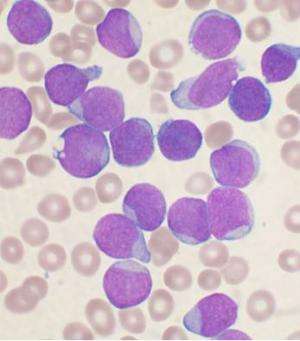First major study of proteins in patients with acute lymphoblastic leukaemia

The most common form of childhood cancer is acute lymphoblastic leukaemia (ALL). Researchers at Lund University in Sweden, in cooperation with Karolinska Institutet, SciLifeLab and the University of Cambridge, have now carried out the most extensive analysis to date of ALL at the protein level, by studying the activity in over 8,000 genes and proteins. The results show aberrant folding in the DNA string, which in turn affects the genes' activity. The study was recently published in Nature Communications.
Approximately 25 per cent of the children who develop ALL have a form of leukaemia that is characterised by the diseased cells containing too many chromosomes, known as hyperdiploidy. Sometimes up to 67 chromosomes are found in a single cell.
"We have previously shown that the genes on the extra chromosomes control the development of leukaemia by becoming more active. This induces an imbalance in the cells which, for example, may then begin to divide faster", says Kajsa Paulsson, associate professor at Lund University and last author of the study.
However, the exact mechanisms at work have been unclear up to now. In the new study, researchers examined the activity in more than 8,000 genes and proteins—something that had never previously been done on this scale for this form of cancer.
The advantage of examining proteins is that it is more biologically relevant. If only the RNA level is examined and then translated to the protein level, the connection is not completely clear, explains Kajsa Paulsson.
"It is a newer field and examining the protein levels is more difficult, but the advantage is that it gives us a better picture of how the cell is controlled compared with only studying the genes," says Janne Lehtiö, professor at Karolinska Institutet and co-author of the study.
In the hyperdiploid leukaemias, the researchers noted lower levels of the CTCF protein and the protein complex cohesin, which control how the DNA string is folded in the cell, compared with the leukaemias that do not have extra chromosomes. The researchers therefore examined how DNA is folded in hyperdiploid leukaemia and were able to observe that a proportion of cases showed aberrant folding.
"How DNA is folded is important for the regulation of when genes are to be active or not. We could also see that the hyperdiploid leukaemias showed signs of dysregulated genes, something that probably contributes to the onset of the disease," says Paulsson.
Continuing research will focus on identifying the proportion of DNA that displays aberrant folding. The results of the study are important for understanding how hyperdiploid childhood leukaemia arises and what drives the cancer process.
"Today, there is a 90 per cent cure rate for children with ALL, due to extensive treatment using chemotherapy. In the future, we hope to be able to develop even better treatments that provide an even greater chance of a cure and fewer side effects," concludes Kajsa Paulsson.
More information: Minjun Yang et al, Proteogenomics and Hi-C reveal transcriptional dysregulation in high hyperdiploid childhood acute lymphoblastic leukemia, Nature Communications (2019). DOI: 10.1038/s41467-019-09469-3
















